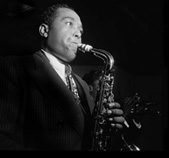Thank a Kansas City jazz artist
April 1, 2007
It’s virtually impossible to say that you wholeheartedly dislike jazz because, let’s face it, jazz is the overwhelming influence/basis for almost every type of popular music today. You like rock? Thank a jazz artist. Is hip-hop your favorite? Yep, thank a jazz artist. Country fans? Thank inbreeding (I kid, I kid). With all of the originality and inspiration found in the jazz movement, it’s nice to know that one of its pioneers called a familiar place home. Kansas City (you know, that big city just east of here) is where jazz saxophonist and innovator Charlie “Yardbird” Parker called home.
Parker’s first acquaintance with music came from his school band, where he fell in love with the alto saxophone. In 1935, Parker quit school (which, ironically enough, was where he learned all of his formal music teachings) to play with local Kansas City bands. For four years, Parker stayed in Kansas City, but in 1939 he moved to New York City, being hooked by its atmosphere and culture. Working various odd jobs around New York, Parker pursued a music career with jazz pianist Jay McShann. It was with McShann’s ensemble that Parker made his first studio recording.
After developing his original saxophone solo niche with McShann, Parker left to play with pianist Earl Hines. Through touring and playing with Hines, Parker met the celebrated “Dizzy” Gillespie and began dabbling in the newer “bebop-style” jazz. In 1945, Parker and Gillespie took their ensemble to Los Angeles for a six-week tour of the local nightclub scene. It was here where he began his use of drugs, which eventually developed into a serious addiction. As a result of drinking and habitual drug use, Parker was admitted to a Los Angeles rehabilitation center in 1946.
After leaving rehab and Los Angeles in 1947, Parker worked various jobs in nightclubs and studio productions accompanied by other prominent musicians of the time. Parker visited Paris in 1949 and was celebrated by devoted fans of his American recordings. While in Europe, Parker did various recordings and tours, but he also expanded his musical repertoire by experimenting with string instruments.
In 1955, Parker played his final performance at Birdland, a New York nightclub named in his honor. While visiting friend Nica de Koenigswarter a week later, Charlie Parker died as a result of pneumonia exacerbated by prolonged drug use.
Although Charlie “Yardbird” Parker was one of the essential members of the early American bebop movement, his significance was unnoticed by those outside the profound jazz movements of the ’40s and ’50s. It wasn’t until after his death that the innovation and genius of one of the most talented jazz musicians in history gained the respect he rightfully deserved.



